Yokogawa DR240 User Manual

|
|
Instruction |
DR130/DR231/DR241 |
Manual |
Hybrid Recorder |
|
|
|
(Stand-alone model) |
IM DR231-01E
IM DR231-01E
9th Edition

Foreword
Thank you for purchasing the YOKOGAWA Hybrid Recorder DR130, DR231 or DR241.
This User's Manual contains useful information regarding the instrument's functions and operating procedures, as well as precautions that should be observed during use. To ensure proper use of the instrument, please read this manual thoroughly before operating the instrument.
Keep the manual in a safe place for quick reference whenever a question arises. The following manual is provided with the instrument in addition to this manual if communication is specified.
Manual Name |
Manual No. |
DR130/DR231/DR232/DR241/DR242 Communication Interface |
IMDR231-11E |
|
|
Notes
•DARWIN is a system comprising a number of data-acquisition equipment components. In the course of system growth, new models, software and optional features are added to the family to enhance the systems expandability and flexibility. You can check the versions of your equipment and software by referring to the style number (Sn) and release number (Rn) respectively which are shown on the nameplate of the main unit.
When configuring a system, you must confirm that the style number of each component unit and software meets the following requirement:
the release number of a dedicated software package must be the same or higher than the style number of the main unit or subunit where the package is installed and where it performs control. Any equipment/software not meeting these requirements might have incompatible areas with your system configuration.
In this manual, equipment of style S8 is explained.
For unsupported functions as classified by the style number, see the next page.
•The contents of this manual are subject to change without prior notice as a result of improvements in the instrument's performance and functions.
•Every effort has been made in the preparation of this manual to ensure the accuracy of its contents. However, should you have any questions or find any errors, please contact your nearest YOKOGAWA representative as listed on the back cover of this manual.
•Copying or reproduction of all or any part of the contents of this manual without YOKOGAWA's permission is strictly prohibited.
Trademarks
MS-DOS and Windows are registered trademarks of Microsoft Corporation. IBM is a registered trademark of International Business Machines Corporation.
Revisions
1st Edition: January 1996 2nd Edition: March 1996 3rd Edition: June 1996
4th Edition: September 1996 5th Edition: March 1997 6th Edition: September 1997 7th Edition: November 1998 8th Edition: June 2000
9th Edition: October 2000
Disk No. RE04
9th Edition: October 2000 (YK)
All Rights Reserved, Copyright © 1996 Yokogawa Electric Corporation
IM DR231-01E |
1 |

Unsupported Functions As Classified by the Style Number
The following functions are not available for style number S1
•Computation function (including remote RJC)
•Saving and reading of measured data, computated data and set-up data (FDD function)
•Summer/Winter time
•RS-422-A/RS-485 communication module
•Report function
•Ethernet module
•Measurement of active power and apparent power on ch3 to ch6 for power monitor modules
•Flag (for /M1 option)
•Group reset (for /M1 option)
The following functions are not available for style number S2
•Summer/Winter time
•RS-422-A/RS-485 communication module
•Report function
•Ethernet module
•Measurement of active power and apparent power on ch3 to ch6 for power monitor modules
•Flag (for /M1 option)
•Group reset (for /M1 option)
The following functions are not available for style number S3
•Report function
•Ethernet module
•Measurement of active power and apparent power on ch3 to ch6 for power monitor modules
•Flag (for /M1 option)
•Group reset (for /M1 option)
The following functions are not available for style number S4
•Report function
•Ethernet module
•Measurement of active power and apparent power on ch3 to ch6 for power monitor modules
•Flag (for /M1 option)
•Group reset (for /M1 option)
The following functions are not available for style number S5
•Ethernet module
•Measurement of active power and apparent power on ch3 to ch6 for power monitor modules
•Flag (for /M1 option)
•Group reset (for /M1 option)
Products with style number S5 and S6 are not sold.
2 |
IM DR231-01E |


 Checking the Contents of the Package
Checking the Contents of the Package
Unpack the box and check the contents before operating the instrument. In case the wrong instrument or accessories have been delivered, or if some accessories are not present, or if they seem abnormal, contact the dealer from which you purchased them. Futhermore, please contact a Yokogawa representative to order any of parts as follows.
Main Unit DR130/DR231/DR241
Check that the model and suffix code given on the name plate are according to your order.
Model and Suffix Codes
Model |
Suffix Code |
Description |
|
DR130 |
....................... |
|
Hybrid recorder, portable model |
DR231 |
....................... |
|
Hybrid recorder, desktop model |
DR241 |
....................... |
|
Hybrid recorder, panel-mounted model |
|
|
|
|
Memory |
-0 |
.................... |
No memory |
|
-1 |
.................... |
3.5inch floppy disk drive |
|
|
|
|
Software |
|
0 ................. |
Without data acquisition software |
|
|
2 ................. |
With data acquisition software |
|
|
|
|
Input Channel |
-1 .............. |
10ch |
|
|
|
-2 .............. |
20ch |
|
|
-3 .............. |
30ch (for DR231/DR241 only) |
|
|
|
|
Input Type |
|
1 ............ |
Universal input, screw terminal |
|
|
2 ............ |
Universal input, clamp terminal |
|
|
3 ............ |
DCV/TC/DI input, screw terminal |
|
|
4 ............ |
DCV/TC/DI input, clamp terminal |
|
|
|
|
Power Supply |
-1 ......... |
100-240VAC |
|
|
|
-2 ......... |
12-28VDC (for DR241 only) |
|
|
|
|
Power Cord |
|
D ......... |
3-pin inlet w/UL, CSA cable* (Part No. A1006WD) |
|
|
F ......... |
3-pin inlet w/VDE cable* (Part No. A1009WD) |
|
|
R ......... |
3-pin inlet w/SAA cable* (Part No. A1024WD) |
|
|
S ......... |
3-pin inlet w/BS cable* (Part No. A1023WD) |
|
|
W ........ |
3-pin inlet with screw conversion terminal** |
|
|
Y ......... |
3-pin inlet with screw conversion terminal** |
|
|
* For DR130/DR231 only |
|
|
|
** For DR241 only |
|
|
|
|
|
Options |
|
/M1 .. |
Mathematical Func. |
|
|
/M3 .. |
Report Func. |
|
|
/C1 ... |
GP-IB interface |
|
|
/C2 ... |
RS-232-C interface (/C1, /C2, /C3, and /C7 cannot be specified together) |
|
|
/C3 ... |
RS-422-A/RS-485 interface (/C1, /C2, /C3, and /C7 cannot be specified |
|
|
|
together) |
|
|
/C7 ... |
Ethernet interface (/C1, /C2, /C3, and /C7 cannot be specified together) |
|
|
/A4 ... |
Alarm module (10 make contacts) |
|
|
/R1 ... |
DI/DO interface |
|
|
/H1 ... |
Internal illumination (for DR231/DR241 only) |
|
|
/H5 ... |
Carrying handle (for DR231 only) |
|
|
/D2 ... |
deg F Display |
|
|
/L1 ... |
Summer/winter time |
|
|
/N7 ... |
Power Monitor module (single phase use) |
|
|
/N8 ... |
Power Monitor module (three phase use) |
|
|
/P6 ... |
DC Power supply (for DR130/DR231 only) |
|
|
|
|
NO. (Instrument Number), Style number (equipment) and Release number (software package)
Please refer to these numbers when contacting the dealer.
IM DR231-01E |
3 |
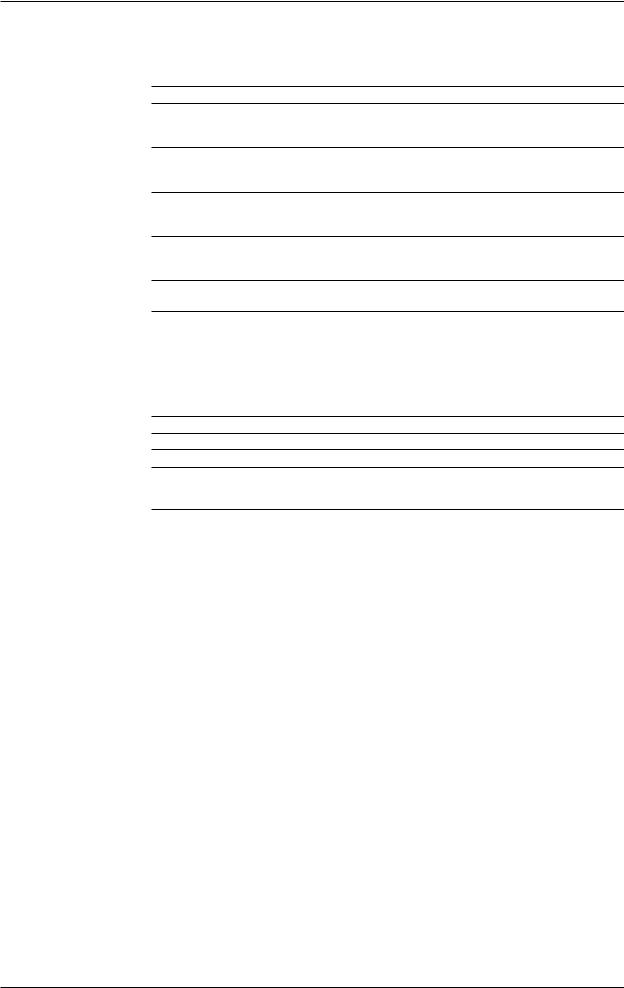
Checking the Contents of the Package
Modules
Check that the model code given on the name plate is according to your order. Note that the input modules at the DR130/DR231/DR241 are fixed and cannot be moved.
Model Codes
Description
10-channel universal input module, screw terminal
20-channel universal input module, screw terminal
30-channel universal input module, screw terminal
10-channel universal input module, clamp terminal
20-channel universal input module, clamp terminal
30-channel universal input module, clamp terminal
10-channel DCV/TC/DI input module, screw terminal
20-channel DCV/TC/DI input module, screw terminal
30-channel DCV/TC/DI input module, screw terminal
10-channel DCV/TC/DI input module, clamp terminal
20-channel DCV/TC/DI input module, clamp terminal
30-channel DCV/TC/DI input module, clamp terminal
Power monitor module, single-phase use
Power monitor module, three-phase use
Optional Modules
Check that the model code given on the name plate is according to your order. Note that the modules at the rear of the main unit are fixed and cannot be moved.
Model Codes
Description
DI/DO module, screw terminal
Alarm module (10 make contacts), screw terminal
GP-IB module
RS-232-C module, D-sub terminal
RS-422-A/RS-485 module
4 |
IM DR231-01E |
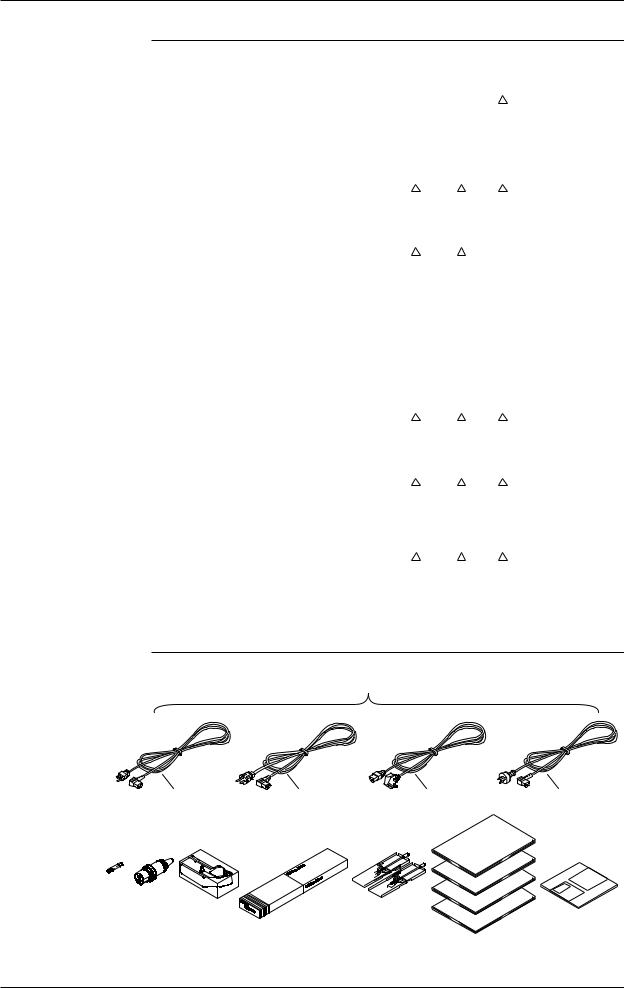
Checking the Contents of the Package
Standard Accessories
Name |
Part No. |
Q'ty |
Presence/Absence |
Description |
||
|
|
|
|
|
|
|
|
|
|
DR130 |
DR231 |
DR241 |
|
1.Power cord |
see page 3 |
1 |
|
|
|
|
2.Fuse |
A1350EF |
1 |
|
|
|
Timelag 2.5A |
|
|
|
|
|
|
250V, in case of |
|
|
|
|
|
|
DR130/231 |
|
|
|
|
|
|
located in fuse |
|
|
|
|
|
|
holder, when |
|
|
|
|
|
|
power supply is |
|
|
|
|
|
|
-1 |
|
A1354EF |
1 |
|
|
|
Timelag 6.3A |
|
|
|
|
|
|
250V, when |
|
|
|
|
|
|
power supply is |
|
|
|
|
|
|
-2 or option /P6 is |
|
|
|
|
|
|
specified |
3.DC power terminal |
A1105JC |
1 |
|
|
|
(only when /P6 is |
connector |
|
|
|
|
|
specified) |
4.Ribbon cassette |
B9627AZ |
1 |
|
|
|
10 colors |
5.Chart paper |
B9627AY |
1 |
|
|
|
Recording width |
|
|
|
|
|
|
250 mm, length |
|
|
|
|
|
|
30 m, |
|
|
|
|
|
|
grid 25 mm |
|
B9855AY |
1 |
|
|
|
Recording width |
|
|
|
|
|
|
150 mm, length |
|
|
|
|
|
|
20 m, |
|
|
1 × 2 |
|
|
|
grid 10 mm |
6.Mounting brackets |
B9900CW |
|
|
|
|
|
7.User's Manual |
IMDR231-01E |
1 |
|
|
|
this manual |
|
IMDR231-11E |
1 |
|
|
|
Communication |
|
|
|
|
|
|
Interface manual |
|
|
|
|
|
|
(only when /C1, |
|
|
|
|
|
|
/C2, /C3, or /C7 |
|
|
|
|
|
|
are specified) |
|
IMDP12013-61E |
|
|
|
|
Data conversion |
|
|
|
|
|
|
software manual |
|
|
|
|
|
|
(comes with |
|
|
|
|
|
|
models with |
|
|
|
|
|
|
whose software |
|
|
|
|
|
|
code is “2”) |
8.Data acquisition software |
DP120-13 |
1 |
|
|
|
Software |
DAQ 32 |
|
|
|
|
|
compatible with |
|
|
|
|
|
|
Windows 95/98 |
|
|
|
|
|
|
and Windows NT |
(comes with models whose software code is “2”)
 : Provided depending on the specifications.
: Provided depending on the specifications.
1.One of these power cord types is supplied according to the instrument's suffix code
|
|
D |
F |
S |
R |
|
|
|
|
|
7. |
2. |
3. |
4. |
5. |
6. |
|
8.
IM DR231-01E |
5 |

Name |
Model |
Description |
Shunt resistance |
DV300-011 |
10Ω, for screw |
Shunt resistance |
DV300-012 |
10Ω, for clamp |
Shunt resistance |
DV300-101 |
100Ω, for screw |
Shunt resistance |
DV300-102 |
100Ω, for clamp |
Shunt resistance |
DV300-251 |
250Ω, for screw |
Shunt resistance |
DV300-252 |
250Ω, for clamp |
Rack mount kit |
DV400-013 |
for DR231 |
Rack mount kit |
DV400-015 |
for DR130 |
|
|
|
Optional Software
Name |
Model |
Description |
|
DAQ 32 |
DP120-13 |
Windows 95/98 and Windows NT |
|
DAQ 32 Plus |
DP320-13 |
Windows 95/98 and Windows NT |
|
Name |
Model |
Min. Q’ty |
Description |
Ribbon cassette |
B9627AZ |
1 |
10 colors |
Chart paper |
B9627RY |
10 |
Recording width 250mm length 30 m, grid 10mm (for |
Checking the Contents of the Package |
|
|
DR231/DR241) |
B9627AY |
10 |
Recording width 250mm length 30 m, grid 25mm (for |
|
|
|
DR231/DR241) |
|
B9855AY |
10 |
Recording width 150mm length 20 m, grid 10mm (for |
|
|
|
DR130) |
|
Optional Accessories |
|
|
|
Spares
6 |
IM DR231-01E |
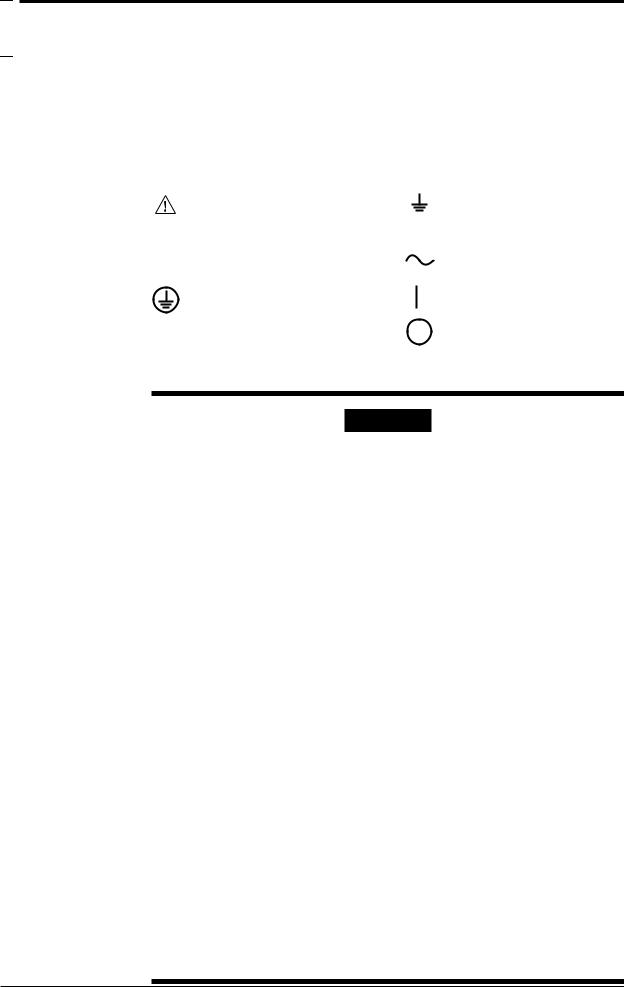

 Safety Precautions
Safety Precautions
This instrument is an IEC safety class I instrument (provided with terminal for protective grounding).
The following general safety precautions must be observed during all phases of operation, service and repair of this instrument. If this instrument is used in a manner not sepecified in this manual, the protection provided by this instrument may be impaired. Also, YOKOGAWA Electric Corporation assumes no liability for the customer’s failure to comply with these requirements.
The following symbols are used on this instrument.
To avoid injury, death of personnel or damage to the instrument, the operator must refer to an explanation in the User’s Manual or Service Manual.
Protective grounding terminal.
Function grounding terminal. This terminal should not be used as a “Protective grounding terminal”.
Alternating current.
ON(power).
OFF(power).
Make sure to comply with the following safety precautions. Noncompliance might result in injury, death of personnel or damage to the instrument.
WARNING
Power Supply
Ensure the source voltage matches the voltage of the power supply before turning ON the power.
Power Cord and Plug
To prevent an electric shock or fire, be sure to use the power cord supplied by YOKOGAWA. The main power plug must be plugged in an outlet with protective grounding terminal. Do not invalidate protection by using an extension cord without protective grounding.
Protective Grounding
Make sure to connect the protective grounding to prevent an electric shock before turning ON the power.
Necessity of Protective Grounding
Never cut off the internal or external protective grounding wire or disconnect the wiring of protective grounding terminal. Doing so poses a potential shock hazard.
Defect of Protective Grounding and Fuse
Do not operate the instrument when protective grounding or fuse might be defective.
Do not Operate in an Explosive Atmosphere
Do not operate the instrument in the presence of flammable liquids or vapors. Operation of any electrical instrument in such an environment constitutes a safety hazard.
Fuse
To prevent a fire, make sure to use fuses with specified standard(current, voltage, type). Before replacing the fuse, turn OFF the power and disconnect the power source. Do not use a different fuse or short-circuit the fuse holder.
Do not Remove any Covers
There are some areas with high voltages. Do not remove any cover if the power supply is connected. The cover should be removed by qualified personnel only.
External Connection
To ground securely, connect the protective grounding before connecting to measurement or control unit.
IM DR231-01E |
7 |


 How to Use this Manual
How to Use this Manual
This User's Manual consists of the following fourteen chapters.
Chapter |
Title |
Description |
Chapter 1 |
System Configuration |
Explains the position of the DR within DARWIN, its |
|
|
configuration, etc.. |
Chapter 2 |
Functions |
Explains the functions of the DR. Operating |
|
|
procedures are not explained here. |
Chapter 3 |
Installation and Wiring |
Describes cautions for use, explains how to install and |
|
|
wire the DR, the power cord, how to switch ON/OFF |
|
|
the DR, how to set the date/time, explains the noise |
|
|
filter, etc.. |
Chapter 4 |
Setting the Monitor Mode |
Explains the display in the monitor mode. |
|
Display |
|
Chapter 5 |
Setting the Input Type/ |
Explains the operations when setting the input type, |
|
Recording Span/ |
recording span and linear scaling function. |
|
Linear Scaling |
|
Chapter 6 |
Setting the Recording |
Explains the operations when setting recording |
|
Conditions |
conditions such as the recording mode, channels, |
|
|
recording interval, chart speed, recording span, and |
|
|
recording format. |
Chapter 7 |
Executing Recording |
Explains how to start and stop recording. |
Chapter 8 |
Setting, Displaying and |
Explains how to set an alarm and what to do when an |
|
Recording Alarms |
alarm occurs. |
Chapter 9 |
Event/Action Function and |
Explains how to operate the event/action function,. |
|
Other Functions |
how to copy recording information, how to reset |
|
|
alarms, how to reset the timer, how to use the key- |
|
|
lock, and how to use the external in-/output function. |
Chapter 10 |
Basic Settings (SET UP) |
Explains functions which usually do not need to be |
|
|
changed, and how to set these. |
Chapter 11 Saving/Reading Measured, Computed and Set-up Data disk
Explains how to save measured data, computed data and set-up data to the internal RAM disk or floppy and read them into the instrument.
Chapter 12 |
Executing Computation |
Explains the computation function (optional). |
|
(Available with the /M1 Model) |
|
Chapter 13 |
Trouble-Shooting and |
Explains maintenance procedures, error messages and |
|
Maintenance |
calibration procedures. |
Chapter 14 |
Specifications |
Explains specifications for all features of DR. |
Index |
|
Gives the index in main menu and alphabetic order. |
|
|
|
8 |
IM DR231-01E |
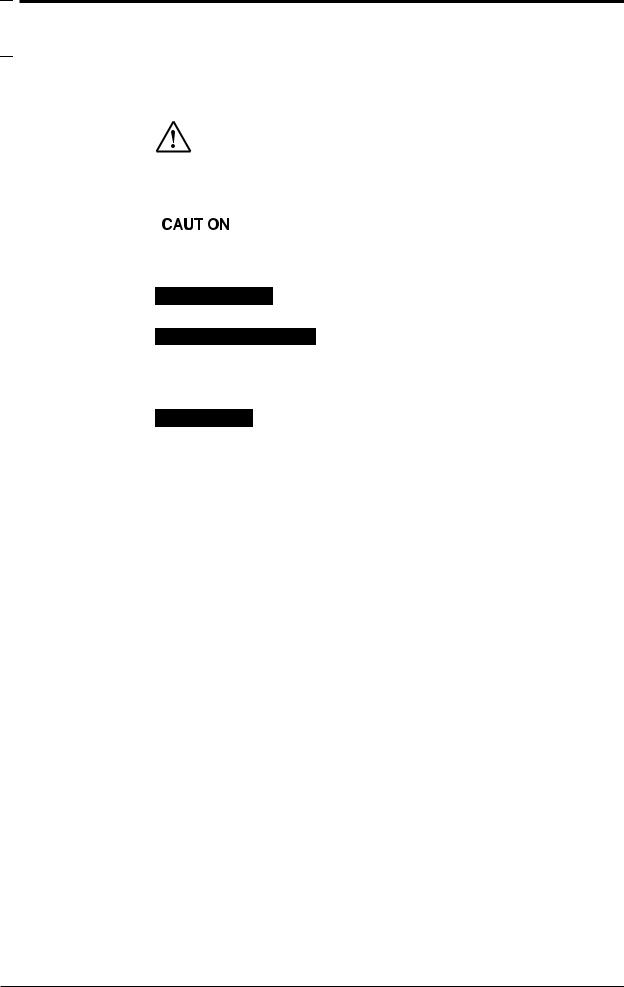

 Conventions Used in this Manual
Conventions Used in this Manual
Used Symbols
The following symbol marks are used to attract the operator's attention.
|
|
|
Affixed to the DR130/231/241, indicating that for safety, the operator |
|
|
|
should refer to the appropriate User's Manual. For a list of the User's |
|
|
|
Manuals, refer to page 1. |
|
|
|
Describes precautions that should be observed to prevent the danger of |
|
|
|
|
|
|
|
injury or death to the user. |
|
|
|
Describes precautions that should be observed to prevent damage to the |
|
|
|
|
|
|
|
DR130/231/241. |
|
|
|
|
Note |
Provides information that is important for proper operation of the DR130/ |
||
|
|
|
231/241. |
Relevant Keys
Operating Procedure
Indicates the relevant panel keys and indicators to carry out the operation.
The procedure is explained by a flow diagram. For the meaning of each operation, refer to the example below. The operating procedures are given with the assumption that you are not familiar with the operation. Thus, it may not be necessary to carry out all the steps when changing settings.
Explanation |
Describes settings and restrictions relating to the operation. |
IM DR231-01E |
9 |

10 |
IM DR231-01E |
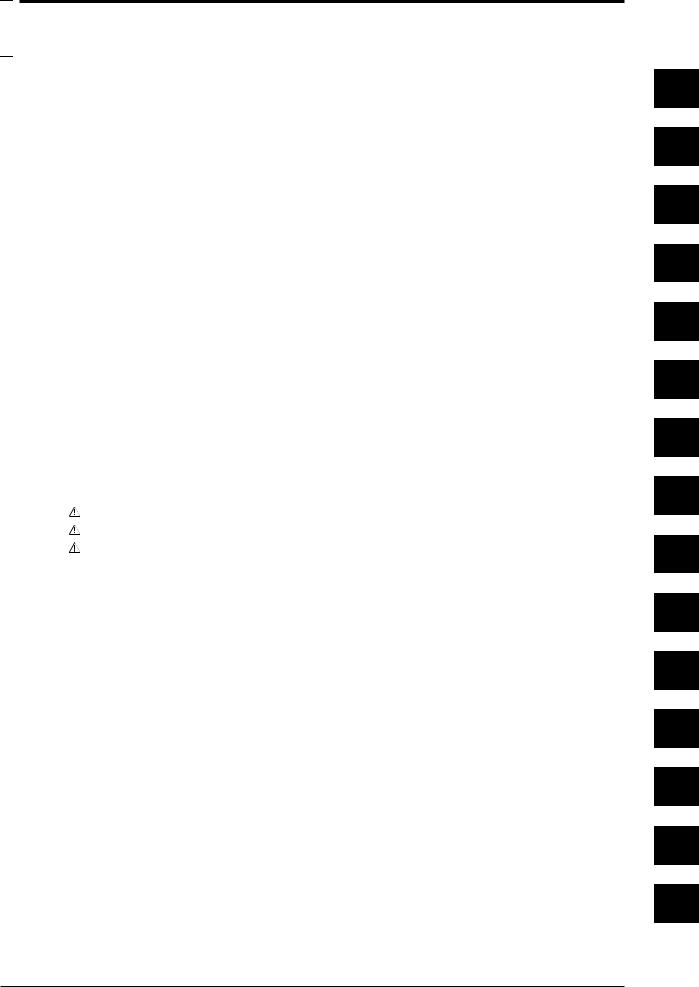

 Contents
Contents
Foreword |
.................................................................................................................................................................................. |
|
1 |
Checking the Contents of the Package ..................................................................................................................... |
3 |
||
Safety Precautions .............................................................................................................................................................. |
7 |
||
How to Use this Manual .................................................................................................................................................... |
8 |
||
Conventions Used in this Manual ................................................................................................................................ |
9 |
||
List of Menus ....................................................................................................................................and Set-up Data |
14 |
||
Chapter 1 |
System Configuration |
|
|
................................................................................................................................... |
1.1 |
About DARWIN |
1-1 |
...................................................................................................................................... |
1.2 |
Names of Parts |
1-2 |
.......................................................................................................................................... |
1.3 |
Floppy Disk |
1-5 |
Chapter 2 |
Functions |
|
|
................................................................................................................................. |
2.1 |
Display Functions |
2-1 |
.............................................................................................................. |
2.2 |
Measurement Input Functions |
2-3 |
............................................................................................................................. |
2.3 |
Recording Functions |
2-5 |
................................................................................................................................... |
2.4 |
Alarm Function |
2-14 |
....................................................................................................... |
2.5 |
Standard Computation Functions |
2-17 |
.................................................................................................................................. |
2.6 |
Other Functions |
2-18 |
Chapter 3 Installation and Wiring |
|
||
..................................................................................................... |
3.1 |
General Precautions for Installation |
3-1 |
....................................................................................................................................... |
3.2 |
How to Install |
3-2 |
............................................................................................. |
3.3 |
Installing the Chart and Ribbon Cassette |
3-6 |
......................................................................................................... |
3.4 |
Connecting the Interface Cables |
3-11 |
............................................................................................................... |
3.5 |
Connecting the Signal Lines |
3-16 |
.......................................................... |
3.6 |
Connecting the Power Cable and Turning the Power ON/OFF |
3-21 |
.................................................................................................................. |
3.7 |
Setting the Date and Time |
3-25 |
................................................................................................................................ |
3.8 |
Countering Noise |
3-26 |
Chapter 4 Setting the Monitor Mode Display |
|
||
......................................................................................................................... |
4.1 |
Using the AUTO Mode |
4-1 |
............................................................................................................... |
4.2 |
Using the MANUAL Display |
4-4 |
...................................................................................................................... |
4.3 |
Using the PAGE Display |
4-6 |
................................................................................................. |
4.4 |
Using the ALARM SEARCH Display |
4-7 |
........................................................................................................... |
4.5 |
Using the BARGRAPH Display |
4-9 |
................................................................................................. |
4.6 |
Using the ALARM STATUS Display |
4-10 |
.................................................................................................. |
4.7 |
Using the RELAY STATUS Display |
4-11 |
........................................................................................ |
4.8 |
Using the CLOCK (Date & Time) Display |
4-13 |
Chapter 5 Setting the Input Type/Recording Span/Linear Scalling |
|
||
..................................................................................... |
5.1 |
Setting the Type of Input and Recording Span |
5-1 |
................................................................................... |
5.2 |
Setting Linear Scaling and the Recording Span |
5-4 |
5.3Configuring the Input Range and Recording Span or the Linear Scaling of a Power Monitoring
Channel ................................................................................................................................................. |
5-6 |
1
2
3
4
5
6
7
8
9
10
11
12
13
14
Index
IM DR231-01E |
11 |

Contents
Chapter 6 Setting the Recording Conditions
6.1 |
Setting the Recording Mode/Engineering Unit/Recording Channel and Recording Interval |
.............. 6-1 |
6.2 |
Setting the Chart Speed ........................................................................................................................ |
6-4 |
6.3 |
Setting Recording Zones and Partially Expanded Recording .............................................................. |
6-6 |
6.4 |
Setting Tag, Digital Printout and Manual Printout ............................................................................... |
6-8 |
6.5 |
Setting the Alarm Printout .................................................................................................................. |
6-10 |
6.6 |
Setting Scale Printout, List Printout and List Format ......................................................................... |
6-12 |
6.7 |
Entering Messages, Headers and Title ................................................................................................ |
6-14 |
6.8 |
Setting Match Time, Moving Average, Interpolation and Groups ...................................................... |
6-16 |
Chapter 7 Executing Recording |
|
|
7.1 |
Starting Dot Printing, Digital Printing and Printing in Logging Mode ................................................ |
7-1 |
7.2 |
Starting Manual Printing, List Printing and Header Printing ............................................................... |
7-2 |
7.3 |
Starting Message Printing ..................................................................................................................... |
7-3 |
7.4 |
Printing Set-up Lists ............................................................................................................................. |
7-4 |
Chapter 8 |
Setting Displaying and Recording Alarms |
|
|
|
8.1 |
Setting Alarms and Relays (including internal switches) |
..................................................................... 8-1 |
|
8.2 |
Alarm Display and Printing .................................................................................................................. |
8-4 |
Chapter 9 |
Event/Action Function and Other Functions |
|
|
|
9.1 |
Setting Event/Action Functions ............................................................................................................ |
9-1 |
|
9.2 |
Copying .............................................................................................................................................. |
9-12 |
9.3Alarm Acknowledgment, Alarm Reset, Timer Reset, Computation, Keylock, and Message Printout 9-14
9.4Clearing Alarm/Message Buffers, and Displaying and Initializing Module/Communications
|
Information ......................................................................................................................................... |
9-16 |
9.5 |
Fail/Chart End Output, and Remote Control Signal Input ................................................................. |
9-18 |
9.6 |
Summer/Winter Time ......................................................................................................................... |
9-19 |
Chapter 10 Basic Settings (SET-UP)
10.1 |
Selecting Adjustment of Dot-Printing Position or Scan Interval ........................................................ |
10-1 |
10.2 |
Setting Recording Format ................................................................................................................... |
10-3 |
10.3 |
Select Alarm Interval/Hysteresis/Hold/A/D Converter Integration Time/Filter................................. |
10-7 |
10.4 |
Setting Operation Mode of Relay/Internal Switch ............................................................................. |
10-9 |
10.5 |
Setting Burn-out/Reference Junction Compensation ....................................................................... |
10-12 |
10.6 |
Setting Recording Colors.................................................................................................................. |
10-14 |
10.7 |
Setting Key Lock ................................................................................................................................ |
10-15 |
10.8 |
Setting FUNC/FUNC3 Menu ........................................................................................................... |
10-17 |
10.9 |
Setting SET/SET3 Menu .................................................................................................................. |
10-20 |
10.10 |
Selecting Display Update Interval, Registering SET UP Menu, and Terminating SET UP Menu .. |
10-24 |
10.11 |
Selecting the temperature unit from °C or °F (option) ...................................................................... |
10-25 |
10.12 Working with the Report Function .................................................................................................... |
10-27 |
|
Chapter 11 Saving/Reading Measured, Computed and Set-up Data
11.1 |
Saving Measured and Computed Data .................................................................................................. |
11-1 |
11.2 |
Reading Measured and Computed Data ................................................................................................. |
11-7 |
11.3 |
Saving Set-up Data ............................................................................................................................... |
11-11 |
11.4 |
Reading Set-up Data ............................................................................................................................ |
11-13 |
11.5 |
Copying a Data File ............................................................................................................................. |
11-16 |
11.6 |
Copying in ASCII Format .................................................................................................................... |
11-18 |
11.7 |
Deleting a Data File ............................................................................................................................. |
11-21 |
11.8 |
Displaying RAM Disk and Floppy Disk Information .......................................................................... |
11-22 |
11.9 |
Initializing the RAM Disk .................................................................................................................... |
11-24 |
11.10 Formatting a Floppy Disk .................................................................................................................. |
11-25 |
|
12 |
IM DR231-01E |

|
|
Contents |
Chapter 12 Executing Compuration (Available with the /M1 Model) |
|
|
12.1 |
Overview of the Computation Function ............................................................................................. |
12-1 |
12.2 |
Setting a Computation Equation ......................................................................................................... |
12-4 |
12.3 |
Setting a Constant ............................................................................................................................... |
12-7 |
12.4 |
Starting/Stopping Computation .......................................................................................................... |
12-8 |
12.5Setting Actions to be Carried out in Case of Computation Error and Setting the Time Axis for TLOG
|
SUM .................................................................................................................................................. |
12-12 |
Chapter 13 Trouble-shooting and Maintenance |
|
|
13.1 |
Periodic Maintenance and Recommended Parts Replacement Period ............................................... |
13-1 |
13.2 |
Replacing the Fuse ................................................................................................................................ |
13-2 |
13.3 |
Troubleshooting .................................................................................................................................. |
13-4 |
13.4 |
Error Codes ......................................................................................................................................... |
13-5 |
13.5 |
Calibration .......................................................................................................................................... |
13-7 |
Chapter 14 Specifications |
|
|
14.1 |
Specifications of DR130/DR231/DR241 (Style S8) .......................................................................... |
14-1 |
14.2 |
Specifications of Optional Functions ............................................................................................... |
14-16 |
14.3 |
Dimensional Drawings ..................................................................................................................... |
14-20 |
INDEX |
|
|
1
2
3
4
5
6
7
8
9
10
11
12
13
14
Index
IM DR231-01E |
13 |


 List of Menus and Set-up Data
List of Menus and Set-up Data
The following is a list of set-up data, procedures to switch to different setting modes, and setting menu.
Measurement Condition Settings
Parameters |
Procedure |
Selecting menu |
Reference |
Input type, span, linear |
RANGE key |
001-01:VOLT/2V |
Chapter 5 |
scaling*1 |
SET key*2 |
|
|
Units |
SET=UNIT |
Section 6.1 |
|
Moving average |
Press the SET key for about three seconds*2 |
SET=MOVE AVE |
Section 6.8 |
Measurement cycle*1 |
Turn ON power while pressing the DISP key |
SET UP= |
Section 10.1 |
A/D integration time*1 |
|
SCAN INTVL |
|
Turn ON power while pressing the DISP key |
SET UP=A/D INTG |
Section 10.3 |
|
Filter*1 |
Turn ON power while pressing the DISP key |
SET UP=FILTER |
Section 10.3 |
*1: Make sure that the total number of setting changes, including calibrations, does not surpass 100000. *2: Procedure varies according to the menu configuration of the SET key (see section 10.9).
Chart Speed Settings
Parameters |
Procedure |
Selecting menu |
Reference |
Chart speed 1 |
CHART key |
CHART |
Section 6.2 |
Chart speed 2 |
Press the SET key for about three seconds* |
SET=CHART2 |
Section 6.2 |
|
|
|
|
*: Procedure varies according to the menu configuration of the SET key (see section 10.9).
Recording Settings
Parameters |
Procedure |
Selecting menu |
Reference |
Logging/Analog trend |
SET key* |
SET=SYSTEM |
Section 6.1 |
switch, dot-printing cycle |
|
|
|
Recording channel |
SET key* |
SET=TREND |
Section 6.1 |
Recording zone |
Press the SET key for about three seconds* |
SET=ZONE |
Section 6.3 |
Partial compression |
Press the SET key for about three seconds* |
SET=PERTIAL |
Section 6.3 |
Tag |
Press the SET key for about three seconds* |
SET=TAG |
Section 6.4 |
Channel to digital print, |
Press the SET key for about three seconds* |
SET=DIGITAL PR |
Section 6.4 |
number of rows to print |
|
|
|
Channel to manual print |
Press the SET key for about three seconds* |
SET=MANUAL PR |
Section 6.4 |
Alarm print |
Press the SET key for about three seconds* |
SET=ALARM PR |
Section 6.5 |
Channel to print scale |
Press the SET key for about three seconds* |
SET=SCALE PR |
Section 6.6 |
values |
|
|
|
Channel to list print |
Press the SET key for about three seconds* |
SET=LIST PR |
Section 6.6 |
Items to list print |
Press the SET key for about three seconds* |
SET=LIST FMT |
Section 6.6 |
Message |
Press the SET key for about three seconds* |
SET=MESSAGE |
Section 6.7 |
Header |
Press the SET key for about three seconds* |
SET=HEADER |
Section 6.7 |
Title |
Press the SET key for about three seconds* |
SET=TITLE |
Section 6.7 |
Interpolation |
Press the SET key for about three seconds* |
SET=INTERPOL |
Section 6.8 |
Adjust dot-printing |
Turn ON power while pressing the DISP key |
SET UP=PRN ADJ |
Section 10.1 |
position |
|
|
|
Recording format |
Turn ON power while pressing the DISP key |
SET UP=RECORD |
Section 10.2 |
Dot-print color |
Turn ON power while pressing the DISP key |
SET UP=COLOR |
Section 10.6 |
|
|
|
|
*: Procedure varies according to the menu configuration of the SET key (see section 10.9).
Display Settings
|
Parameters |
Procedure |
Selecting menu |
Reference |
|
Switch display |
DISP key and MODE key |
-------- |
Chapter 4 |
|
Display update interval |
Turn ON power while pressing the |
SET UP=DISPLAY |
Section 10.10 |
|
|
DISP key |
|
|
|
|
|
|
|
Alarm Settings |
|
|
|
|
Parameters |
Procedure |
Selecting menu |
Reference |
Alarm, alarm output |
ALARM key |
001-01:1/OFF |
Section 8.1 |
relay |
|
|
|
Alarm |
Turn ON power while pressing the DISP key |
SET UP=ALARM |
Section 10.3 |
interval/hysteresis/hold |
|
|
|
Execute alarm |
FUNC key* |
ALARM ACK |
Section 9.3 |
acknowledge |
|
|
|
Reset alarm |
FUNC key* |
ALARM RST |
Section 9.3 |
Clear alarm buffer |
Press the FUNC key for about three seconds* |
ALM BUF CLEAR |
Section 9.4 |
|
|
|
|
*: Procedure varies according to the menu configuration of the FUNC key (see section 10.8).
14 |
IM DR231-01E |

List of Menus and Set-up Data
Computation Settings
Parameters |
Procedure |
Selecting menu |
Reference |
Computation equation |
SET key* |
SET=MATH |
Section 12.2 |
Constant |
SET key* |
SET=CONST |
Section 12.3 |
Perform computation |
FUNC key** |
MATH START |
Section 12.4 |
Clear measured data and |
FUNC key** |
MATH CLR START |
Section 12.4 |
perform computation |
|
|
|
Stop computation |
FUNC key** |
MATH STOP |
Section 12.4 |
Clear incomplete |
FUNC key** |
MATH ACK |
Section 12.4 |
measurement status |
|
|
|
Handling of computation Turn ON power while pressing the DISP key |
SET UP=MATH |
Section 12.5 |
|
error/time axis setting of |
|
|
|
TLOG SUM |
|
|
|
|
|
|
|
*: Procedure varies according to the menu configuration of the SET key (see section 10.9). **: Procedure varies according to the menu configuration of the FUNC key (see section 10.8).
Settings for Saving/Loading Measured/Setup Data (Floppy Disk)
|
Parameters |
Procedure |
Selecting menu |
Reference |
|
Save/Load measured data SET key* |
SET=MEMORY |
Section 11.1, 11.2 |
|
|
Save/Load set-up data |
SET key* |
SET=FLOPPY |
Section 11.3, 11.4 |
|
of SET mode |
|
|
|
|
Copy measured data |
SET key* |
SET=MEMORY |
Section 11.5 |
|
between built-in RAM |
|
|
|
|
disk and floppy disk |
|
|
|
|
Convert data and copy |
SET key* |
SET=MEMORY |
Section 11.6 |
|
Initialize built-in RAM |
SET key* |
SET=MEMORY |
Section 11.9 |
|
disk |
|
|
|
|
Initialize floppy disk |
SET key* |
SET=MEMORY |
Section 11.10 |
|
Save/Load set-up data |
Turn ON power while pressing the DISP |
SET UP=FLOPPY |
Section 11.3, 11.4 |
|
of SET UP mode |
key |
|
|
|
|
|
||
|
*: Procedure varies according to the menu configuration of the SET key (see section 10.9). |
|
||
Perform Printing |
|
|
|
|
|
Parameters |
Procedure |
Selecting menu |
Reference |
|
Perform manual print |
PRINT key |
MAN PR START |
Section 7.2 |
|
Perform list print |
PRINT key |
LIST START |
Section 7.2 |
|
Perform header print |
PRINT key |
HEADER START |
Section 7.2 |
|
Perform message print |
FUNC key* |
MSG PRINT |
Section 7.3 |
|
Perform setup list print |
Press the FUNC key for about three seconds* |
S/U LIST START |
Section 7.4 |
|
|
|||
|
*: Procedure varies according to the menu configuration of the FUNC key (see section 10.8). |
|||
Other Settings |
|
|
|
|
Parameters |
Procedure |
Selecting menu |
Reference |
Timer |
SET key* |
SET=TIMER |
Section 6.1 |
Event/Action |
SET key* |
SET=LOGIC |
Section 9.1 |
Copy between channels |
SET key* |
SET=COPY |
Section 9.2 |
Match time |
Press the SET key for about three seconds* |
SET=MATCH TIME Section 6.8 |
|
Group |
Press the SET key for about three seconds* |
SET=GROUP |
Section 6.8 |
Relay, internal switch |
Turn ON power while pressing the DISP key |
SET UP=RELAY |
Section 10.4 |
operation mode |
|
|
|
Burnout |
Turn ON power while pressing the DISP key |
SET UP=BURN OUT Section 10.5 |
|
Reference junction |
Turn ON power while pressing the DISP key |
SET UP=RJC |
Section 10.5 |
compensation |
|
|
|
Key lock |
Turn ON power while pressing the DISP key |
SET UP=LOCK |
Section 10.7 |
Menu configuration |
Turn ON power while pressing the DISP key |
SET UP= |
Section 10.8 |
of FUNC key |
|
FUNC PARM |
|
Menu configuration |
Turn ON power while pressing the DISP key |
SET UP=SET PARM Section 10.9 |
|
of SET key |
|
|
|
Report function |
Turn ON power while pressing the DISP key |
SET UP=REPORT |
Section 10.12 |
Reset timer |
FUNC key** |
TIMER RESET |
Section 9.3 |
Lock keys |
FUNC key** |
KEY LOCK ON |
Section 9.3 |
Start report |
FUNC key** |
REPORT START |
Section 10.12 |
Stop report |
FUNC key** |
REPORT STOP |
Section 10.12 |
Start report print |
FUNC key** |
REPORT RECALL |
Section 10.12 |
|
|
START |
|
Stop report print |
FUNC key** |
REPORT PRINT |
Section 10.12 |
|
|
START |
|
Clear message buffer |
Press the FUNC key for about three seconds** MSG BUF CLEAR |
Section 9.4 |
|
Display module settings |
Press the FUNC key for about three seconds** |
MODULE INF |
Section 9.4 |
Display communication |
Press the FUNC key for about three seconds** |
COMM INF |
Section 9.4 |
settings |
|
|
|
Initialize setting |
Press the FUNC key for about three seconds** |
RAM INIT |
Section 9.4 |
information |
|
|
|
|
|
|
|
*: Procedure varies according to the menu configuration of the SET key (see section 10.9). **: Procedure varies according to the menu configuration of the FUNC key (see section 10.8).
IM DR231-01E |
15 |
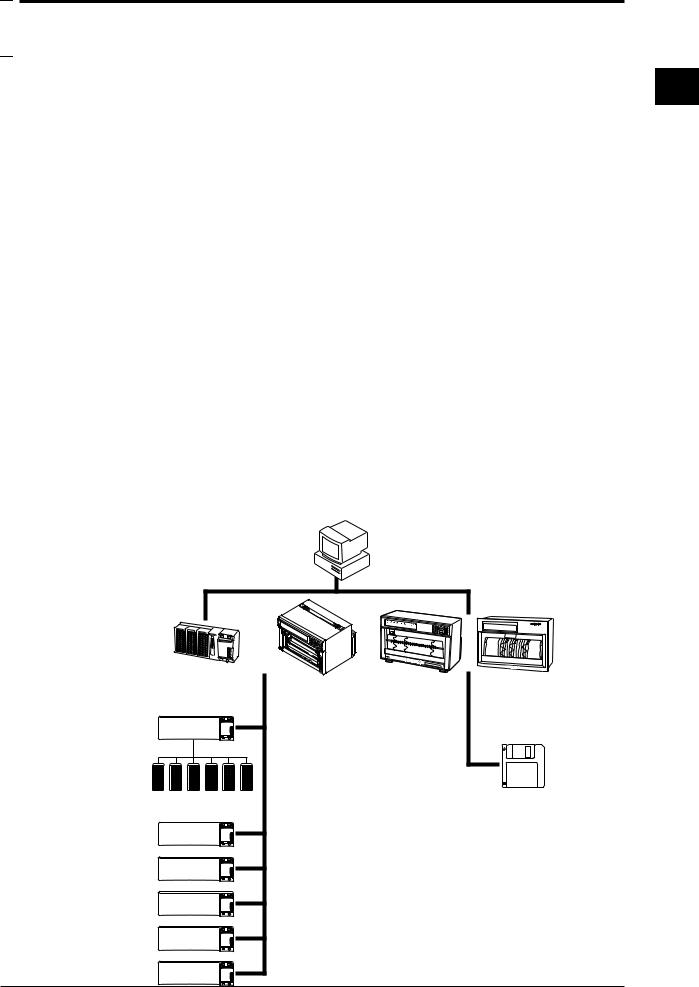

 1.1 About DARWIN
1.1 About DARWIN
What is DARWIN?
Created from a completely new concept that is based on modular architecture, this group of next generation data acquisition systems is called DARWIN (Data Acquistion and Recording Windows).
Today many data acquisition networks are increasingly being linked together. More than ever before, large volume, high speed, accurate, easy-to-use communication functions are essential in many disciplines.
In the world of measurement and control where the number of measurement points has increased sharply, the ability to acquire information from a large number of points easily and economically is crucial. Interfacing to a personal computer allows simplified utilization of the information while improving quality and efficiency.
DARWIN is based on a unique, new concept to meet these needs. The art of measurement is revolutionized by DARWIN which integrates functions of conventional recording and data logging.
Most existing data acquisition equipment has been the all-in-one type in which the measurement section and display/recording section are contained in one box. While this simplifies operation on the one hand, it is difficult to adapt to changes in the measurement environment and also makes expansion difficult.
DARWIN uses a data acquisition engine and remote I/O modules which are completely separate from each other. It is an entirely new product line which quickly and flexibly copes with various restrictive conditions and changes in specifications.
Supported by a personal computer, a whole line-up can be created starting with the data acquisition systems DA series which performs data logging. For example, using a printer as the output device, the equipment becomes a hybrid recorder (DR series).
Three models are available in the DR series: the DR130, DR230 and DR240. The DR130 is a portable hybrid recorder, the DR230 is a desk-top hybrid recorder, and the DR240 is a panelmount hybrid recorder (component type).
Personal computer
|
|
CH=001 RANGE=TC TYPE-T |
DA100 |
DR230 |
DR240 |
DR130 |
||
Subunit |
|
|
Input/output modules |
FD |
||
|
|
|
|
Extension cables (max. length 500 m)
1
Configuration System
IM DR231-01E |
1-1 |
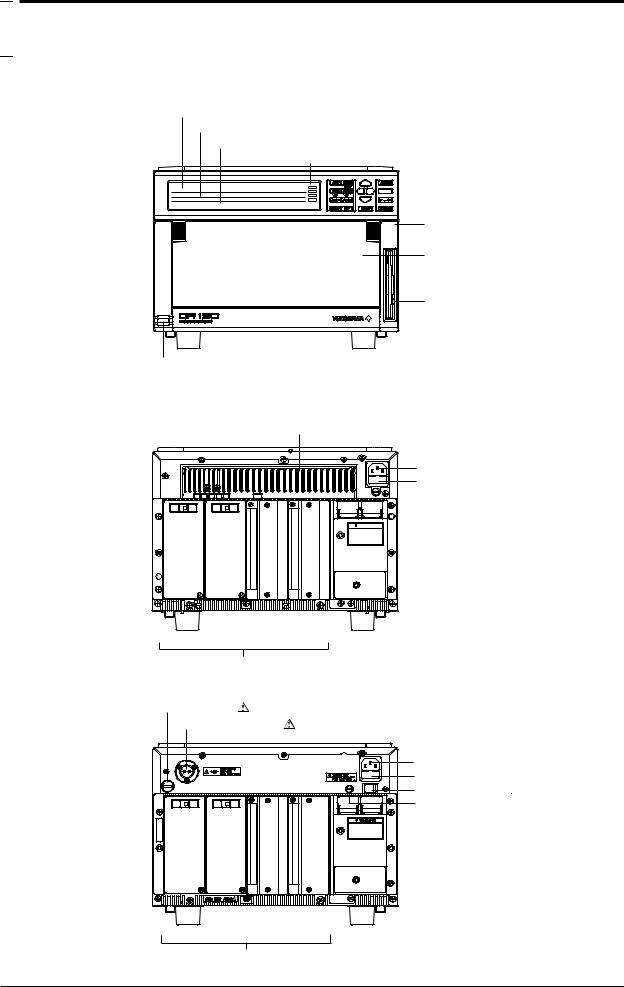

 1.2 Names of Parts
1.2 Names of Parts
DR130 Portable hybrid recorder
Front
Main display (See chapter 4.)
Sub-display 1 (See chapter 4.)
Sub-display 2 (See chapter 4.)
Status indicator

 Operation panel
Operation panel
(See chapters 3 to 12.)
Handle to open/close |
the front door |
Front door |
Floppy disk drive |
(Only for DR130-1) |
Power switch (See page 3-18.)
Rear (Example of DR130 with 20 input channels)
AC power supply model
Heat sink fins
Power connector ( See page 3-21.)
See page 3-21.)
Power fuse ( See page 13-2.)
See page 13-2.)

 Function grounding
Function grounding 
 terminal
terminal
Terminals
DC power supply model
DC Power fuse ( |
See page 13-3.) |
|
DC Power connector ( |
See page 3-23.) |
|
AC Power connector ( See page 3-21.) AC Power fuze (
See page 3-21.) AC Power fuze ( See page 13-2.)
See page 13-2.)
AC Power switch ( See page 3-24.) Function grounding terminal
See page 3-24.) Function grounding terminal
Terminals
1-2 |
IM DR231-01E |
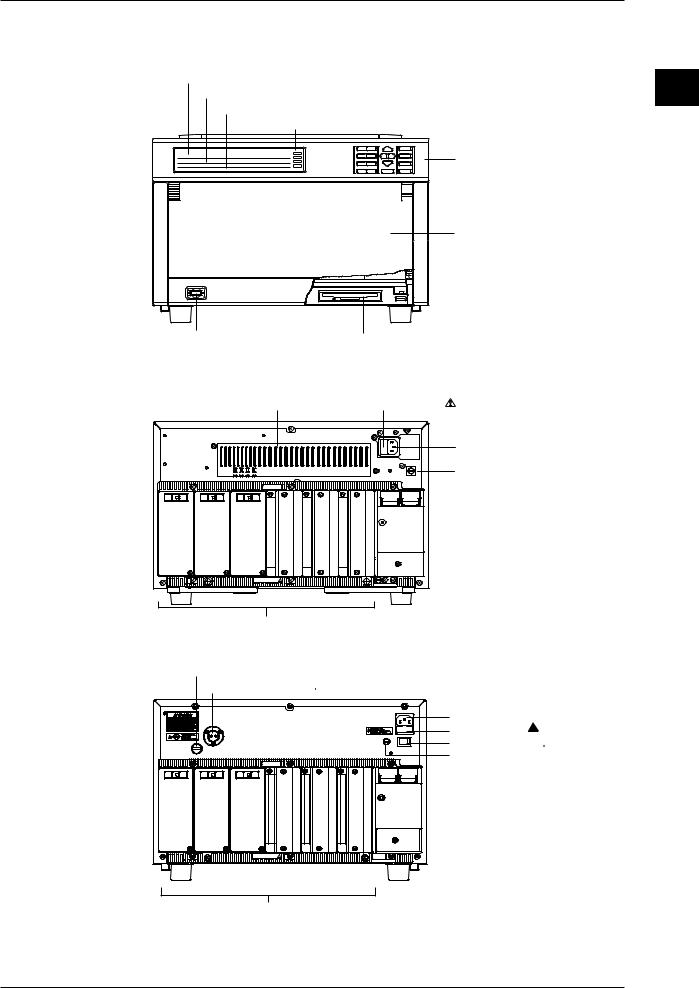
1.2 Names of Parts
DR231 Desk-top hybrid recorder
Front
Main display (See chapter 4.)
Sub-display 1 (See chapter 4.)
Sub-display 2 (See chapter 4.)
Status indicator
Operation panel
(See chapters 3 to 12.)
 Handle to open/close
Handle to open/close  the front door
the front door
Front door
1
Configuration System
Power switch (See page 3-18.) Floppy disk drive (Only for DR231-1)
Rear (Example of DR231 with 30 input channels)
AC power supply model
Heat sink fins |
Power fuse ( See page 13-2.) |
Power connector
( See page 3-21.) Function grounding terminal
See page 3-21.) Function grounding terminal
Terminals
DC power supply model
DC Power fuse (  See page 13-3.)
See page 13-3.)
DC Power connector (  See page 3-23.)
See page 3-23.)
AC Power connector ( See page 3-21.)
See page 3-21.)
AC Power fuze ( See page 13-2.)
See page 13-2.)
AC Power switch ( See page 3-24.)
See page 3-24.)
Function grounding terminal
Terminals
IM DR231-01E |
1-3 |
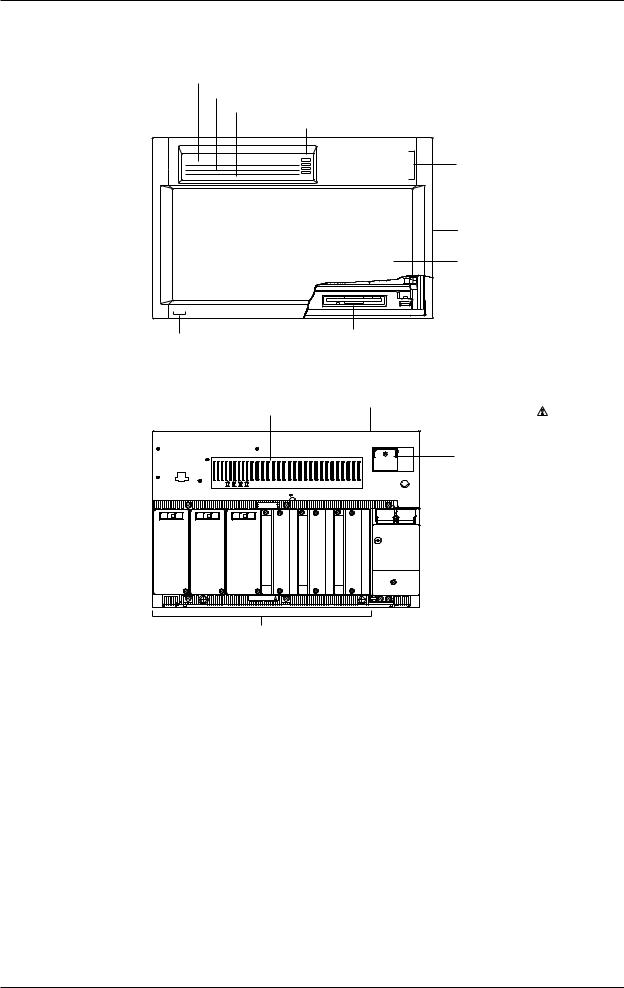
1.2 Names of Parts
DR241 Panel-mount hybrid recorder (component type)
Front
Main display (See chapter 4.)
Sub-display 1 (See chapter 4.)
Sub-display 2 (See chapter 4.)
Status indicator
Operation panel
(Located behind the front door. See chapters 3 to 12.)
Handle to open/close the front door
Front door
Power switch
(Located inside the front door. See page 3-18.)
Rear (Example of DR241 with 30 input channels)
Heat sink fins |
Power fuse |
(Located inside the instrument. See page 13-2.) |
Power terminal with a cover ( See page 3-22.)
See page 3-22.)

 Function grounding terminal
Function grounding terminal
Terminals
1-4 |
IM DR231-01E |
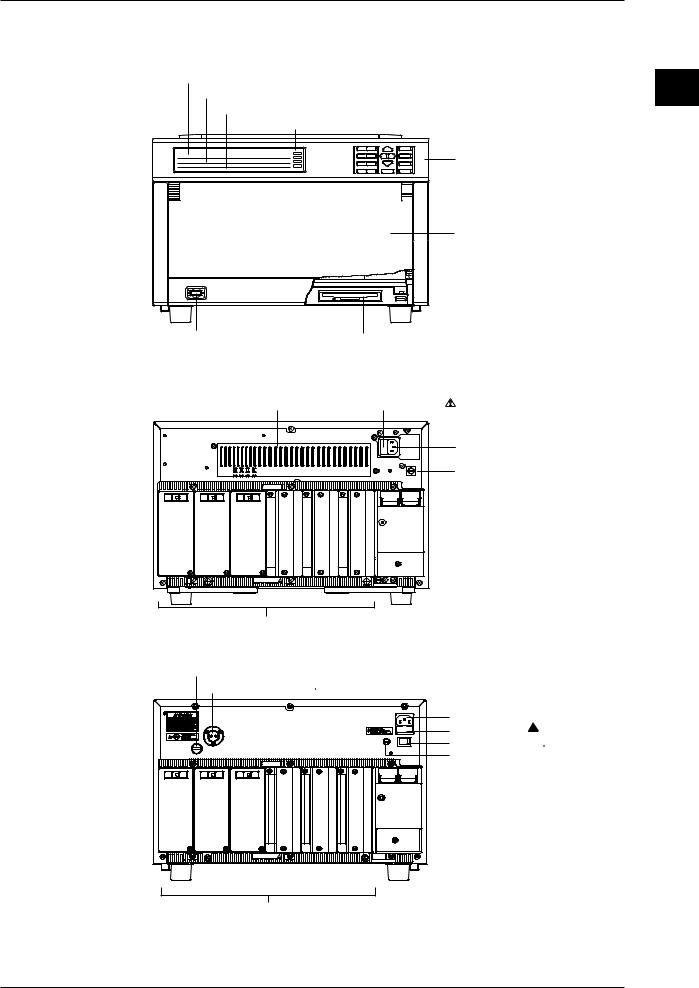
1.2 Names of Parts
DR231 Desk-top hybrid recorder
Front
Main display (See chapter 4.)
Sub-display 1 (See chapter 4.)
Sub-display 2 (See chapter 4.)
Status indicator
Operation panel
(See chapters 3 to 12.)
 Handle to open/close
Handle to open/close  the front door
the front door
Front door
1
Configuration System
Power switch (See page 3-18.) Floppy disk drive (Only for DR231-1)
Rear (Example of DR231 with 30 input channels)
AC power supply model
Heat sink fins |
Power fuse ( See page 13-2.) |
Power connector
( See page 3-21.) Function grounding terminal
See page 3-21.) Function grounding terminal
Terminals
DC power supply model
DC Power fuse (  See page 13-3.)
See page 13-3.)
DC Power connector (  See page 3-23.)
See page 3-23.)
AC Power connector ( See page 3-21.)
See page 3-21.)
AC Power fuze ( See page 13-2.)
See page 13-2.)
AC Power switch ( See page 3-24.)
See page 3-24.)
Function grounding terminal
Terminals
IM DR231-01E |
1-3 |


 2.1 Display Functions
2.1 Display Functions
The inter-active front panel display consists of three rows. The first row is the main display, and the second and third row are sub-display 1 and 2 respectively.
Monitor Mode and Status Display
Monitor Mode
•Auto Mode
This mode can be set for the main display, sub-display 1 and sub-display 2. Measurement values of all channels will be consecutively displayed with update interval.
•Manual Mode
This mode can be set for the main display, sub-display 1 and sub-display 2. Measurement values of a single channel will be displayed. The display update interval is the same as the measurement interval (refer to page 2-4).
•Page Mode
This mode can be set for the main display. When choosing this display, the measurement values of 5 consecutive channels will be displayed as a page using also sub-display 1 and 2. The display update interval is the same as the measurement interval (refer to page 2-4).
•Alarm Search Mode
This mode can be set for the main display, sub-display 1 and sub-display 2. Channels at which an alarm occurred will be searched for and their measurement values displayed. The display update interval is 2 seconds.
•Bargraph Mode
This mode can be set for sub-display 1. Measurement values which are shown on the main display will be shown as a bargraph. The display update interval is the same as the interval of the main display.
•Alarm Status Mode
This mode can be set for sub-display 1 and 2. The display will show per channel whether or not an alarm occurred (refer to page 2-14). On one display the alarm status of a maximum of 30 channels can be monitored (depending on the number of input channels). The display update interval is 0.5 seconds.
•Relay Status Mode
This mode can be set for sub-display 1 and 2. The display will show the operating status of internal switches/alarm output relays (refer to page 2-14). On one display a maximum of 30 relay statuses can be monitored. The display update interval is 1 second.
•Clock Mode
This mode can only be set for sub-display 2. The current date and time are shown.
•Displaying the Selected Mode
To the right of sub-display 1 the currently selected mode is shown for a specific display.
Status Display
Indicators at the right side of the display will light up to show that recording is in progress (refer to page 2-5), alarms are occuring (refer to page 2-14), keys are locked (refer to page 2-18) and chart needs to be replaced (refer to page 2-19).
Remote/Local Status Display
The status of remote/local control will be shown on sub-display 2. Keys cannot be operated in remote control.
2
Functions
IM DR231-01E |
2-1 |

2.1 Display Functions
Display for Setting the Type of Input, Computation and Recording Conditions
Menus for setting each of the following functions will be displayed.
•measurement input functions (refer to page 2-3)
•recording functions (refer to page 2-5)
•alarm functions (refer to page 2-14)
•computation functions (refer to page 2-17)
•event/action function, key-lock function and external in/output function (refer to page 2-18, 19)
Display for Setting Fundamental Functions
Menus for performing fundamental settings will be displayed.
2-2 |
IM DR231-01E |


 2.2 Measurement Input Functions
2.2 Measurement Input Functions
Input Type
DC Voltage
Measurements can be done after selecting the measurement range per channel. The minimum range is 20mV, the maximum range is 50V.
Thermocouple
Measurements can be done after selecting the type of thermocouple per channel. The available types are R, S, B, K, E, J, T, L, U, N, W and KPvsAU7FE.
Reference Junction Compensation (RJC) can be set to either use Internal RJC (INT) or External RJC (EXT) per channel.
Burnout function can be set OFF per channel or it can be selected in which direction the trend line will move if burnout occurs (right or left)
Resistance Temperature Detector
Measurements can be done after selecting the type of resistance temperature detector (RTD) per channel. The available 17 types are Pt100(1mA), Pt100(2mA), JPt100(1mA), JPt100(2mA), Pt50(2mA), Ni100(1mA)SAMA, Ni100(1mA)DIN, Ni120(1mA), J263*B, Cu10GE, Cu10L&N, Cu10WEED, Cu10BAILEY, Pt100 (1mA) high resolution, Pt100 (2mA) high resolution, JPt100 (1mA) high resolution and JPt100 (2mA) high resolution.
Contact Input
The type of contact input can be selected from voltage level input or contact input, and recording can be set ON or OFF per channel. In case of the voltage level input a voltage level up to 2.4V results in recording OFF, whereas a voltage level of 2.4V or more results in recording ON.
AC Voltage/Current
The effective voltage, effective current, active power, reactive power, apparent power, frequency, power factor and phase angle can be measured. The measuring range is common to all terminals. The input terminals of the module with this input mode are not consistent with a setup screen in terms of the channel number.
Skipping Input Channels
This function allows skipping measurement, recording and display of channels you are not using. Measurement, recording and display will not be done for the skipped channels.
Reference Junction Compensation (RJC)
This function is to be used when measuring temperatures using thermocouples. The voltage generated by a thermocouple depends on the temperature of the spot of measurement and the reference junction temprature. Reference junction compensation is a function which compensates the temperature at the side of the measurement instrument to 0 degrees C.
To compensate for the environmental temperature an internal circuit can be selected, or compensation by a fixed compensation voltage value (external) can be set.
2
Functions
IM DR231-01E |
2-3 |
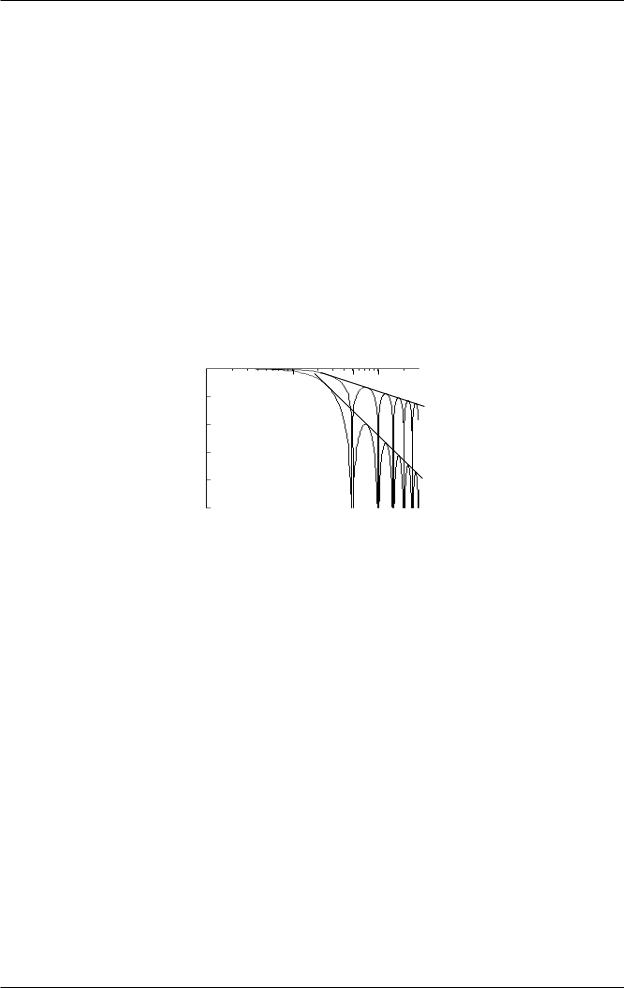
2.2 Measurement Input Functions
Scan Interval
•The duration of time (one scan) in which the measurement of all channels is carried out, is called the scan interval.
•This interval can be set to any value from 2 to 60s, and this range is the same for the 10ch, 20ch and 30ch model.
A/D Integration Time
This instrument measures the input signal after putting it through an A/D converter. In order to minimize the noise imposed on the input signal, specific integration times exist.
The integration time can be selected from 20ms (50Hz), 16.7ms (60Hz) and 100ms (10Hz). When “AUTO” is selected, the integration time will be automatically decided according to the 50/ 60Hz frequency of the power supply.
AUTO does not function if the instrument is a DC power supply model (Selecting “AUTO” will set the A/D integration time to 20 ms (50 Hz)). If you are using the instrument on a 60-Hz power supply, set the A/D integration time to 16.7 ms (60Hz).
Input Filter
A filter can be set ON/OFF to reduce normal mode noise. Effects on normal mode noise are as follows depending on the filter being ON/OFF (theoretical values).
Attenuation
1Hz
0dB
-20dB
-40dB
-60dB
-80dB
Frequency
10Hz 50Hz100Hz 300Hz
 Slope:-20dB/dec
Slope:-20dB/dec
Filter ON 
 Filter OFF
Filter OFF
 Slope:-60dB/dec
Slope:-60dB/dec
-100dB
2-4 |
IM DR231-01E |


 2.3 Recording Functions
2.3 Recording Functions
Chart Speed
The speed at which the chart moves when performing trend recording can be selected from any value between 1 to 1500mm/h.
Two types of chart speeds can be set. When you are not using the Event/Action function, which will be described later on in this manual, chart speed 1 will be valid. When the Event/Action function is being used, you can select whether chart speed 1 will change to speed 2 according to the event status.
Recording Mode
Two types of recording modes are available; analog trend and logging mode. The default setting is analog trend mode.
Analog Trend Mode (refer to the next page for a recording example) Trend Recording (Dot recording)
The recording principle is that, according to measurement data and recording conditions, the correct position on the chart will be decided and on that position the dot will be printed. Trend recording conditions consist of the following.
•chart speed
•channels to be recorded
•recording color (refer to page 2-9)
•recording interval (refer to page 2-9)
•recording span (refer to page 2-10)
•recording zone (refer to page 2-10)
•partially expanded recording (refer to page 2-11)
•interpolation function (refer to page 2-11)
Digital Printout
Measurement data will be printed as numerical values. Digital printout conditions consist of the following.
•channels to be recorded
•recording interval (refer to page 2-9)
•the number of channels to be recorded on the same line (refer to page 2-8)
Logging Mode
In this mode measurement data are only printed as numerical values. Logging recording conditions consist of the following.
•channels to be recorded
•the recording direction (vertical or horizontal)
•recording interval (refer to page 2-9)
2
Functions
IM DR231-01E |
2-5 |
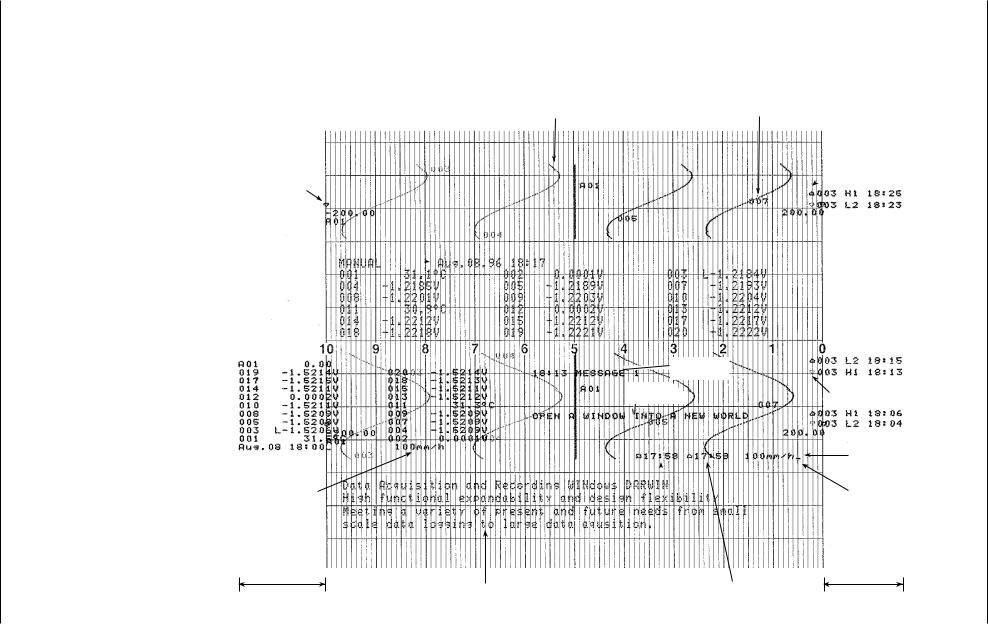
6-2
01E-DR231 IM
Reference point of xcale (Page 2-8)
Scale value  (Page 2-10)
(Page 2-10)
Starting date/time of manual printout
Manual Printout  (Page 2-13)
(Page 2-13)
Channel No. or tag  of manual printout
of manual printout
Digital printout  (Page 2-5)
(Page 2-5)
Starting date/time  of Digital printout
of Digital printout
Chart speed (Page 2-5)
Left margin
Trend recording (Page 2-5)
Header (Page 2-13)
Channel No. or tag of dot recording
Alarm release mark
 (Page 2-13)
(Page 2-13)
Message (Page 2-13)
Title |
Alarm release mark |
|
(Page 2-13) |
(Page 2-13) |
|
|
|
Chart speed |
|
|
(Page 2-5) |
|
|
Reference position of |
|
|
dot recording start |
|
|
(Page 2-8) |
|
|
|
Ending time of |
Starting time |
Right margin |
|
previous dot |
of dot |
||
|
|||
recording |
recording |
|
|
(Page 2-8) |
(Page 2-8) |
|
Example Recording |
Functions Recording 3.2 |
.pages reference to refer parentheses in numbers The
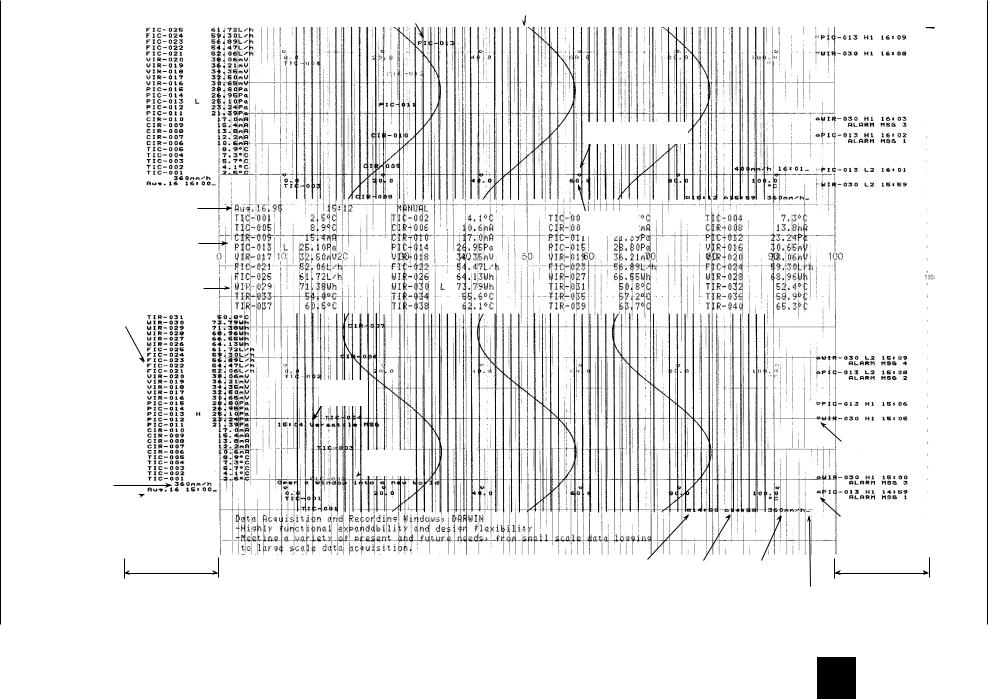
IM |
Channel No. or tag of |
01E-DR231 |
dot recording |
|
Starting date/time of manual printout
Manual Printout (Page 2-13)
Channel No. or tag of manual printout
Digital printout (Page 2-5)
Message (Page 2-13)
Titlle
 (Page 2-13)
(Page 2-13)
Chart speed (Page 2-5)
Starting date/time 
of Digital printout Header  (Page 2-13)
(Page 2-13)
Left margin
7-2
Trend recording (Page 2-5)
Reference point of scale (Page 2-8)
Scaled value (Page 2-10)
Ending time of |
Starting time |
Chart speed |
previous dot |
of dot |
(Page 2-5) |
recording |
recording |
|
(Page 2-8) |
(Page 2-8) |
|
Alarm release mark (Page 2-13)
Alarm occurrence mark (Page 2-13)
parentheses in numbers The |
DR231/DR241 for Example Recording |
.pages reference to refer |
|
Functions Recording 3.2
Functions
2
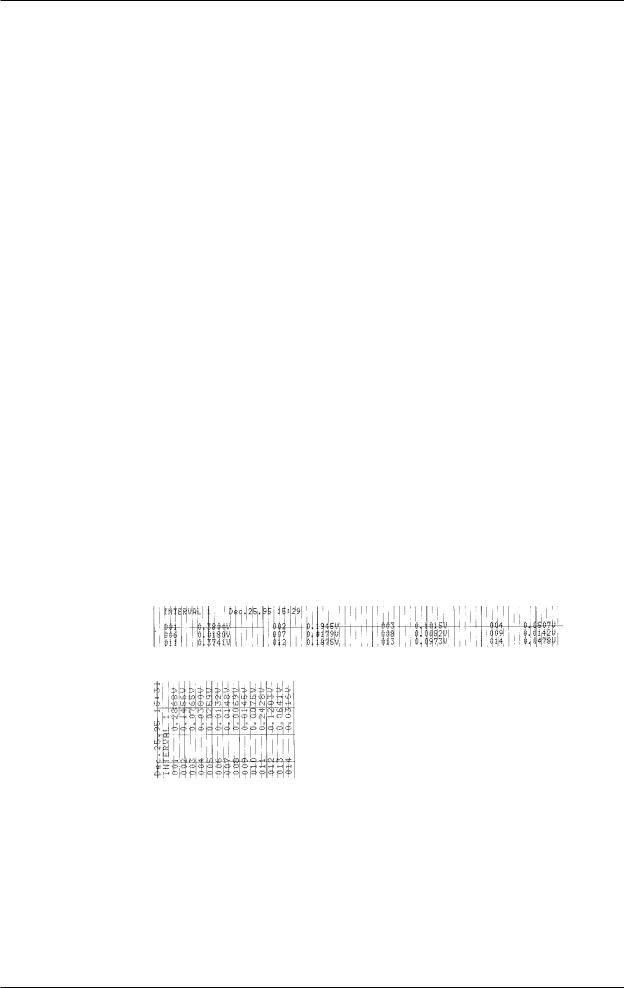
2.3 Recording Functions
Recording Format
You can modify the recording format of measurement values according to your own preferences. The following selections are available.
Items common for Analog Trend and Logging mode Printing Channel No. or Tag
When printing measurement values, the corresponding channel number or a preset tag can be recorded with it. This selection will also affect the display the same way. The number of characters of a tag which will be printed out, can be selected too.
Items for Analog Trend Mode
• Printing Starting/Stopping Time of Recording
You can select whether to print the time of starting/stopping the recording (refer to page 2-10) on the right side of the chart. The first time recording starts after the power has been turned ON, only the starting time will be printed. After that, the current starting time will be printed together with the stopping time of the previous recording. To the right of the starting time a bar will be printed as a reference point to the time of starting.
•Selecting the Number of Columns for Digital Printouts
You can select how many columns (where one column equals data of one channel) will be used in one line for printing out measurement data.
•Selection of the Pitch of Channel Printouts
You can select at which distance the channel numbers (or tags) will be printed. You can also select this printout OFF. When tags have been selected, this distance applies to the tag printout.
•Selection of the Pitch of Title Printouts
You can select at which distances the title will be repeatedly printed. You can also select this printout OFF.
•Selection of the Scaled Values Printout
You can select the printing pattern for scaled values (refer to page 2-10). You can also select this printout OFF.
•Selection of the Reference Point of Scaled Values
You can select whether or not to print a reference point for the positions of the scaled values.
Items for Logging Mode
•Selection of the Recording Direction (Horizontal/Vertical)
You can select whether printouts will occur in horizontal or vertical direction,
Example of a printout in horizontal direction
Example of a printout in vertical direction
2-8 |
IM DR231-01E |

2.3 Recording Functions
Recording Colors
The color of trend recordings can be selected per channel. The colors which can be selected are black, purple, red-purple, navy blue, red, blue, brown, green, orange and yellowish green.
The recording color of the numerical values in the logging mode is purple only.
Recording Interval
The time during which one scan of trend recording or numerical printout is carried out is called the recording interval.
Recording interval for trend recording
This recording interval can be selected from AUTO or FIX.
•AUTO
The recording interval is decided automatically depending on the measurement (scan) interval and chart speed in order prevent the dots from overlapping. However, in cases where this calculation would render the recording interval smaller than the scan interval, the recording interval will equal the scan interval.
Recording interval = Scan interval × N
where N is an integer satisfying N ≤ 720 / (scan interval × chart speed). 720 is fixed.
Example: when scan interval is 2s; chart speed is 100mm/h then N ≤ 720 / (2 × 100) = 3.6
The closest matching integer is 3.
Accordingly, the recording interval becomes 2 × 3 = 6s.
•FIX
Recording is carried out at an interval which is the same as the scan interval (2 to 60s) regardless of the chart speed.
Recording interval for digital printouts
This recording interval can be selected from MULTIPLE or SINGLE
•MULTIPLE
Six preset recording intervals (Timer 1 to 6) can be set and a recording interval can be selected per channel. The timer setting can be selected from relative and absolute.
•Relative time: Time will be counted from the point of turning the power switch ON or of resetting the timer. Each time the preset length of time is reached (and thus when time is up), recording will start.
•Absolute time: A reference time is set, and from that time recording will start at preset time intervals (each time when time is up).
•SINGLE
The logging interval is decided automatically depending on the chart speed and the number of columns for digital printouts.
Recording interval in logging mode
This recording interval can be selected from MULTIPLE or SINGLE
•MULTIPLE
Same as for the analog trend mode
•SINGLE
From the above mentioned six preset recording intervals, the interval set as Timer 1 will become the recording interval.
Resetting the Recording Interval (Timer Reset)
This function will reset the elapsed time of the above mentioned MULTIPLE recording interval to zero. Usually recording will start according to the recording intervals, but when you reset the elapsed time using this function, the results are the same as for time-up.
2
Functions
IM DR231-01E |
2-9 |
